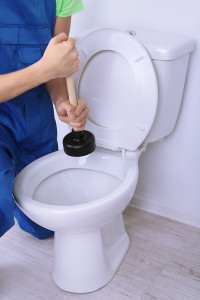 When a toilet is clogged, one of the first things that homeowners do to try to unclog the fixture is flushing again. It’s not outlandish to think that a second rush of water may be able to clear the clog and get things running again, but this is very rarely how unclogging a toilet works. In these instances, that second flush will often cause your toilet to begin to overflow, and an overflowing toilet can put you, your bathroom, and your belongings into a precarious situation. At Plumbing Emergency Rescue, our professionals are always available to save you from an overflowing toilet, but there are some steps you can take before we arrive in order to ensure your property damage and exposure is minimal.
When a toilet is clogged, one of the first things that homeowners do to try to unclog the fixture is flushing again. It’s not outlandish to think that a second rush of water may be able to clear the clog and get things running again, but this is very rarely how unclogging a toilet works. In these instances, that second flush will often cause your toilet to begin to overflow, and an overflowing toilet can put you, your bathroom, and your belongings into a precarious situation. At Plumbing Emergency Rescue, our professionals are always available to save you from an overflowing toilet, but there are some steps you can take before we arrive in order to ensure your property damage and exposure is minimal.
First, if your toilet begins to overflow, you’ll want to shut the water off as quickly as possible. On many toilets in the Long Island, Suffolk County, and Nassau County regions, there will be a small shutoff valve located under the tank, and this will cut off the water supply to the toilet so the overflow will stop. In some cases, however, there is no shut off valve, and you’ll need to remove the lid on the tank and hold the float ball to stop the tank from refilling, while another person turns off the water using your home’s main shutoff valve.
With the water turned off to the toilet, the toilet should cease overflowing, and you can then begin the cleanup process as you wait for your plumber to arrive. When cleaning up water or soiled belongings after a toilet overflow, it’s always important to wear protective gloves and clothing so you can spare yourself from coming into contact with harmful bacteria stemming from the toilet water.
After calling an emergency plumber, your toilet will be able to return to working order again. Whether the problem was due to a clog, or something more serious, a professional will know just how to stop the overflow and leave you with a working and suitable toilet fixture.
